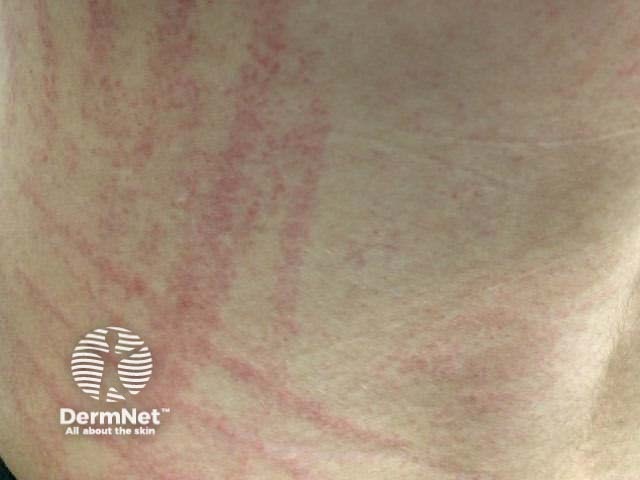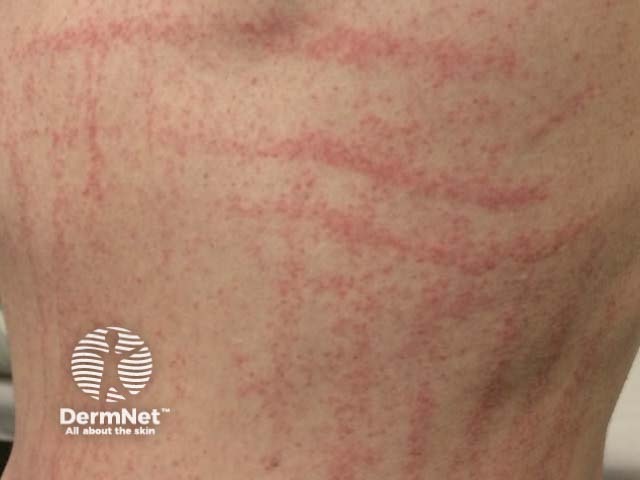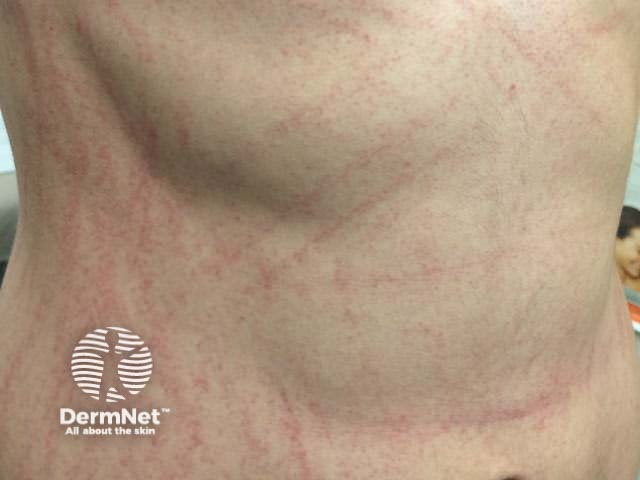Main menu
Common skin conditions

NEWS
Join DermNet PRO
Read more
Quick links
Shiitake flagellate dermatitis — extra information
Shiitake flagellate dermatitis
Author: Emma Trowbridge, Registrar, Department of Dermatology, Christchurch Hospital, Christchurch, New Zealand, January 2016. Updated by Lauren Thomas, 3rd Year Postgraduate Medical Student, Flinders University, Northern Territory, Australia; Chief Editor: Dr Amanda Oakley, Dermatologist, Hamilton, New Zealand, September 2016.
Introduction Demographics Causes Clinical features Diagnosis Differential diagnoses Treatment
What is shiitake flagellate dermatitis?
Shiitake dermatitis is a distinctive rash that can occur following the ingestion of raw or undercooked shiitake mushrooms (Lentinula edodes).
It is characterised by pruritic, erythematous, linear streaks that resemble whiplash marks, hence the name flagellate.
Shiitake dermatitis is also known as flagellate erythema and toxicodermia.
Who gets shiitake flagellate dermatitis?
China and Japan have the highest rates of consumption of shiitake mushrooms and the highest prevalence of shiitake dermatitis. It affects about 2% of people that consume the mushrooms raw or only lightly cooked. It has been reported in people of all ages, who are more often male than female.
More cases of shiitake dermatitis are being diagnosed in other countries where the use of shiitake mushrooms is increasing.
What causes shiitake flagellate dermatitis?
Shiitake flagellate dermatitis is a toxic reaction to lentinan, found in fresh, powdered, or lightly cooked shiitake mushrooms. Lentinan is a thermolabile polysaccharide that activates interleukin 1 secretion, leading to vasodilation, haemorrhage and rash.
This hypothesis is supported by the observation that shiitake dermatitis is not seen with the ingestion of thoroughly cooked at a temperature > 145 C.
Flagellate dermatitis does not result from cutaneous contact with the mushrooms.
What are the clinical features of shiitake flagellate dermatitis?
The flagellate rash of shiitake dermatitis typically appears 24 hours after ingestion of raw or undercooked shiitake mushrooms.
- Onset can occur within a few hours and up to 5 days after ingestion of the mushrooms.
- Itchy erythematous papules and sometimes petechiae are arranged in linear streaks.
- There may be localised swelling.
- They most often affect the trunk, but may also affect limbs, neck and head. It does not affect mucosal surfaces.
- The rash can be worse on exposure to the sun.
- Associated gastrointestinal symptoms can occur.
The rash spontaneously resolves within a few weeks.

Shiitake flagellate erythema

Shiitake flagellate erythema

Shiitake flagellate erythema
See more images of shiitake flagellate dermatitis.
Systemic symptoms
Some patients with shiitake flagellate dermatitis have other symptoms.
- Localised oedema
- Malaise
- Fever
- Lip tingling (has been reported 48 hours after eating)
- Discomfort when swallowing
- Diarrhoea
- Tingling of hands and feet
How is shiitake flagellate dermatitis diagnosed?
The diagnosis is clinical, based on the characteristic history of recent mushroom ingestion and on the appearance of the rash. There are no specific laboratory findings. Usual tests may include:
- Full blood count
- Urea and electrolytes
- Liver function tests.
Histopathology is nonspecific, demonstrating focal hyperkeratosis, spongiosis, dermal oedema and perivascular lymphocytic infiltrate with eosinophils.
What is the differential diagnosis of shiitake flagellate dermatitis?
Flagellate erythema is also associated with:
- Drug reactions to bleomycin, peplomycin and docetaxel
- Dermatomyositis
- Adult-onset Still disease.
Raw shiitake mushrooms can also rarely induce contact allergic dermatitis in sensitised individuals.
What is the treatment of shiitake flagellate dermatitis?
Shiitake flagellate dermatitis is a self-limiting condition. It is unknown if treatment speeds up the resolution of the rash.
- Oral antihistamines
- Topical corticosteroids
- Affected individuals should protect their skin from sun exposure while the rash is resolving.
There is generally improvement within 2 days and complete resolution after 3 weeks.
Prevent future attacks by ensuring that Shiitake mushrooms are thoroughly cooked before eating.
References
- Boels D, Landreau A, Bruneau C, Garnier R, Pulce C, Labadie M, de Haro L, Harry P. Shiitake dermatitis recorded by French Poison Control Centers – new case series with clinical observations. Clin Toxicol (Phila). 2014 Jul;52(6):625–8. PubMed
- Adriano AR, Acosta ML, Azulay DR, Quiroz CD, Talarico SR. Shiitake dermatitis: the first case reported in Brazil. An Bras Dermatol. 2013 May–Jun;88(3):417–9. PubMed
- Hamer S, Rabindranathnambi R. A wide-spread flagellate dermatitis. BMJ Case Reports [internet]. 2013 [cited 2016 Jan 13];[2 p.]. DOI: 10.1136/bcr-2012-007682. PubMed.
- Corazza M, Zauli S, Ricci M, Borghi A, Pedriali M, Mantovani L, et al. Shiitake dermatitis: toxic or allergic reaction? Journal of the European Academy of Dermatology and Venereology. 2015;29(7):1449–51. PubMed
- Adler MJ, Larsen WG. Clinical variability of shiitake dermatitis. Journal of the American Academy of Dermatology. 2012;67(4):e140–e1. PubMed
- Karanovic S, George S, Topham E. Don’t miss shiitake dermatitis: a case report. British Journal of General Practice. 2014;64(625):426–7. PubMed
On DermNet
Other websites
- Shiitake Dermatitis Alert — North American Mycological Association
